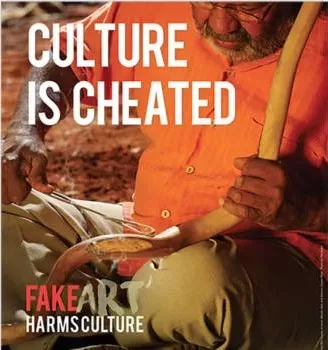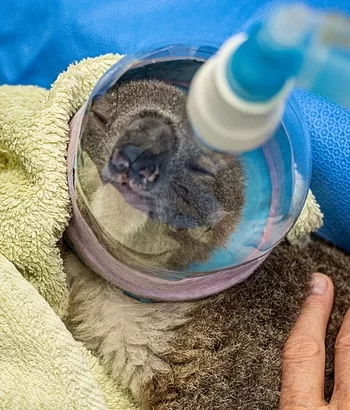Aboriginal and Torres Strait Islander artists and businesses have been disadvantaged by the sale of inauthentic arts and crafts, which leads to cultural and economic harm.
Misleading products, including fake indigenous paintings and boomerangs, clapping sticks and digeridoos, t-shirts and ties, are typically mass produced in Asia with no Indigenous involvement.
Two in three products in the $80 million dollar Indigenous-style souvenirs market are fake with no connection to Aboriginal and Torres Strait Islander people, the Productivity Commission said in a report: www.pc.gov.au/indigenous-arts.
The Australian Productivity Commission found that annual sales of Aboriginal and Torres Strait Islander visual arts and crafts, including souvenirs, were at least $250 million, supporting thousands of jobs — many in remote communities — and are a major drawcard for tourists.
Many visual arts and crafts misappropriate sacred cultural symbols and stories, undermining customary laws and causing harms and offence. Many Aboriginal and Torres Strait Islander artists engage successfully with art dealers, galleries and consumers — often through community-controlled art centres.
There are still instances of unscrupulous behaviour towards artists. Aboriginal and Torres Strait Islander people remain under-represented in management and leadership roles in the sector. The Productivity Commission recommends a comprehensive set of actions to tackle these problems.
The Productivity Commission’s final report on Aboriginal and Torres Strait Islander visual arts and crafts provides a series of recommendations that will be considered by the Government in their proposed Cultural Rights Legislation.
Recommendations and findings
Aboriginal and Torres Strait Islander arts and crafts are a cornerstone of culture
Finding 2.1 Aboriginal and Torres Strait Islander arts and crafts generate broad cultural and economic benefits
Visual arts and crafts markets are substantial, diverse and growing
Finding 3.1 The total value of annual spending on Aboriginal and Torres Strait Islander visual arts and crafts — including artworks and consumer products — exceeds $250 million
Finding 3.2 Visual arts and crafts sales contribute to the economic wellbeing of Aboriginal and Torres Strait Islander artists
Finding 3.3 Artworks by independent artists have a material presence in Aboriginal and Torres Strait Islander visual arts and crafts markets
Finding 3.4 Art centres are the major source of production and sales of art from remote areas
Inauthentic visual arts and crafts are pervasive and cause cultural harm and economic costs
Finding 4.1 Several factors contribute to assessments of the authenticity (or not) of Aboriginal and Torres Strait Islander visual arts and crafts
Finding 4.2 Inauthentic Aboriginal and Torres Strait Islander arts and crafts are rife in the consumer product, digital and print-on-demand merchandise markets
Finding 4.3 Inauthentic visual arts and crafts have wide-ranging negative effects
Finding 4.4 Difficulties for consumers in identifying authentic products and gaps in legal protections for ICIP are the main enablers of inauthentic arts and crafts
Recognising cultural rights to protect the ICIP in visual arts and crafts
Finding 5.1 Stronger legal protection for Indigenous Cultural and Intellectual Property in Aboriginal and Torres Strait Islander visual arts and crafts would reduce misappropriation
Finding 5.2 Dedicated legal protections are the best way to address misappropriation of Indigenous Cultural and Intellectual Property in visual arts and crafts
Finding 5.3 There are advantages to taking a multi-pronged approach to protecting Indigenous Cultural and Intellectual Property
Recommendation 5.1 An Indigenous Cultural and Intellectual Property strategy to coordinate policy development
Recommendation 6.1 New cultural rights legislation should be introduced to empower traditional owners to decide how their cultural assets are used in visual arts and crafts
Finding 6.1 A cultural rights regime must balance the interests of traditional owners and those seeking to access and use cultural assets
Recommendation 6.2 The foundational elements of the cultural rights legislation should be progressed
Mandating the disclosure of non-Indigenous authorship
Finding 7.1 Some measures to help consumers assess the authenticity of Aboriginal and Torres Strait Islander art and craft products are in place but information gaps remain
Finding 7.2 Voluntary industry-wide labelling schemes for authentic products can be useful marketing tools but are unlikely to comprehensively help consumers distinguish products made by non-Indigenous people
Finding 7.3 Education and awareness raising measures should complement other initiatives
Finding 7.4 Banning non-Indigenous authored non-Indigenous authored products is not a proportionate policy option
Recommendation 7.1 Mandatory disclosure where products are non-Indigenous authored should be required
Strengthening legal and other support services for artists
Finding 8.1 Unethical conduct towards Aboriginal and Torres Strait Islander artists still occurs
Finding 8.2 Enforcement of the Indigenous Art Code is constrained by resourcing
Finding 8.3 Clear guidelines are not widely available to inform how governments can ethically procure and use Aboriginal and Torres Strait Islander art and design services
Finding 8.4 The case for an ACCC-enforced mandatory or voluntary Indigenous art code is not strong
Recommendation 8.1 Strengthening Indigenous Art Code Limited
Finding 8.5 Artists face difficulties accessing legal and other support services
Recommendation 8.2 Ensuring support services are accessible and centre artists’ needs
There is scope to improve government support to the sector
Finding 9.1 Government funding is fragmented and can be difficult to track
Finding 9 .2 Shortcomings in funding arrangements affect the ability of art organisations to support artists and communities
Recommendation 9.1 Australian Government funding should be evaluated to inform future arrangements
Recommendation 9.2 Aboriginal and Torres Strait Islander people should be part of shared decision making in setting objectives for government funding for visual arts and crafts
Building the Aboriginal and Torres Strait Islander arts workforce requires explicit and strategic policy intent
Finding 10.1 Gaps and deficiencies in training contribute to under-representation of Aboriginal and Torres Strait Islander people in some roles and positions in the visual arts industry
Finding 10.2 The Aboriginal and Torres Strait Islander visual arts and crafts workforce falls in a policy gap
Recommendation 10.1 Improving government support for Aboriginal and Torres Strait Islander visual arts and crafts workforce development
Recommendation 10.2 Public cultural institutions should expand opportunities for Aboriginal and Torres Strait Islander visual arts and crafts workers
°°°°°°°
“We support measures to strengthen protections for First Nations Cultural and Intellectual Property and ensure the rights of First Nations people to own and control their cultural heritage. We acknowledge the Government’s commitment to developing stand-alone legislation. The Australia Council’s Protocols for using First Nations Cultural and Intellectual Property in the Arts offer best-practice guidelines and are a condition of funding for artists and organisations that receive Australia Council investment.”
Australia Council Executive Director First Nations Arts and Culture Franchesca Cubillo said:
Minister for Indigenous Australians, Linda Burney, said inauthentic arts and crafts prevent Aboriginal and Torres Strait Islander artists and businesses from receiving fair returns for their unique work and talent.
“Arts and crafts are central to expressing culture, sharing traditional stories, connecting to Country, and provide valuable employment and economic opportunities for First Nations peoples,” Minister Burney said.
“This Productivity Commission report states that about 60 per cent of international visitors make purchases of fake art with an even higher percentage of inauthentic ‘Indigenous-style designs’ available on the digital image market.
“This needs to change and we will carefully review the recommendations from the final report as part of our commitment to advancing an ethical marketplace that empowers First Nations artists to protect their cultural assets.
“Strengthening the capacity of the sector, and minimising the prevalence of unauthorised products are all steps required to better support Aboriginal and Torres Strait Islander artists and businesses to continue creating arts and crafts products, and be fairly remunerated.”
Minister for Indigenous Australians, Linda Burney, said
Minister for the Arts, Tony Burke, said the report’s recommendations will build on the Government’s groundwork in strengthening authentic and ethically produced First Nations arts and crafts, through its landmark National Cultural Policy.
“For too long, fake ‘Indigenous-style’ merchandise has undercut legitimate artists, misled consumers and caused a number of cultural harms – this has to stop,” Minister Burke said.
“We’re committed to cracking down on this deliberate cultural theft – and the recommendations from this report will help inform that.”
Minister for the Arts, Tony Burke, said
Mr Burke said he is committed to working with First Nations people to establish stand-alone legislation to protect traditional knowledge and cultural expressions.
“Inauthentic Indigenous-style products mislead consumers, deprive Aboriginal and Torres Strait Islander artists of income and disrespect cultures”
“Communities have limited legal avenues to stop their cultures from being used without permission and out of context,” he said.
Productivity Commissioner Romlie Mokak said.
“Mandatory disclosure where products are not made or licensed by an Aboriginal and Torres Strait Islander person would steer consumers toward authentic products and put the compliance burden on those producing fake products, not Aboriginal and Torres Strait Islander artists.
“In combination with new cultural rights legislation, we consider mandatory disclosure to be a more proportionate and practical response than trying to ban inauthentic products,”
Commissioner Lisa Gropp said.
Webinar: Cultural Rights Legislation
This webinar is about our draft recommendations on new cultural rights legislation to strengthen protections for Indigenous Cultural and Intellectual Property (ICIP) in visual arts and crafts. The webinar focussed on the key design aspects of the proposed legislation.
This event was held online on 31 August 2022. It took the form of a short presentation, followed by Q&A.
Further details on the Government’s intention to deliver better long-term outcomes for Aboriginal and Torres Strait Islander artists and businesses will be released as part of the National Cultural Policy.
The Productivity Commission is calling for the Australian Government to introduce legislation that will enable Aboriginal and Torres Strait Islander communities to protect important aspects of their cultures from being misappropriated in visual arts and crafts.
The Commission recommends strengthening the supports available to artists through the Indigenous Art Code, and reviewing the adequacy and effectiveness of government funding, to ensure it aligns with community priorities, and supports future growth in the Aboriginal and Torres Strait Islander visual arts and crafts workforce.
The report on Aboriginal and Torres Strait Islander visual arts and crafts is here: www.pc.gov.au/indigenous-arts.


With thanks to Indigenous Art Code’s Fake Art Harms Culture campaign for the graphic.
Related feature stories
Origin of “Welcome to Country” Nimbin Aquarius Festival 1973
Uluru Statement from the heart & Paul Keating’s 1992 Redfern Speech
The Block at Redfern, Sydney, site of the 2004 Redfern riots
Australian Aboriginal spears taken by James Cook repatriated
Warlimpirrnga Tjapaltjarri, central Australian artist, one of the Pintupi Nine
“Lost tribe happy in modern world” says Melbourne newspaper
The Bulletin’s 2004 story on the Pinputi Nine





